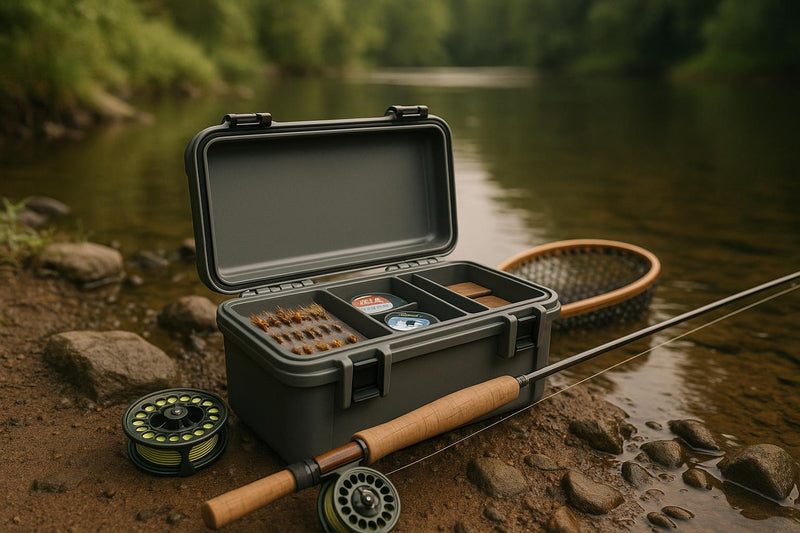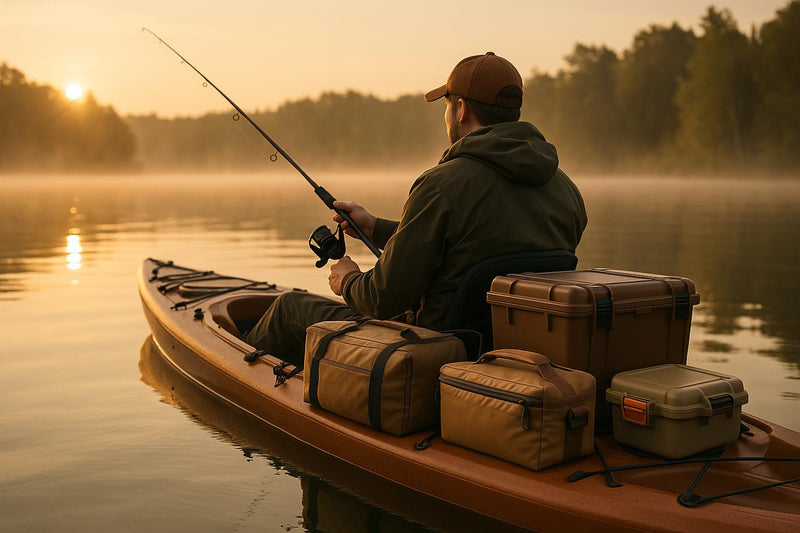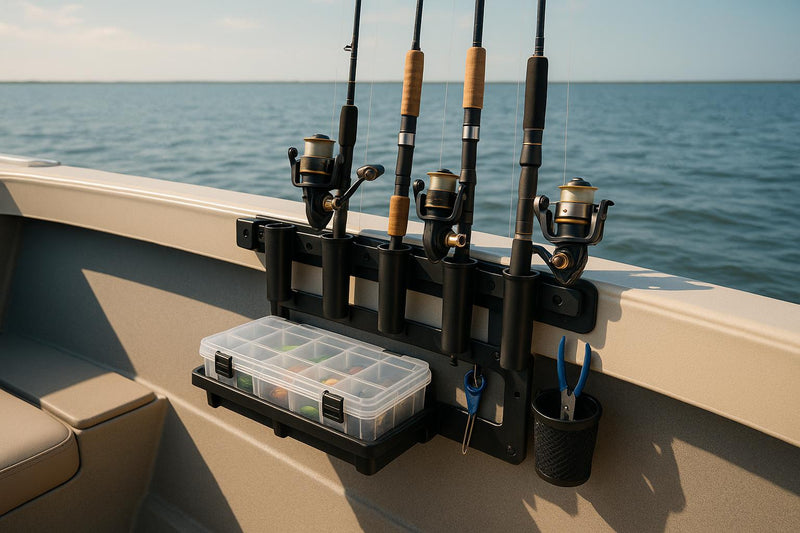When you're out fishing, protecting your electronics from water is non-negotiable. Waterproof cases safeguard smartphones, GPS devices, fish finders, and cameras from water damage, salt corrosion, and accidental drops. Here's what you need to know:
- Key Features: Look for cases with high waterproof ratings (IPX7 or IPX8), buoyancy to prevent sinking, and shock resistance for impact protection.
- Types of Cases: Options include soft pouches for portability, rigid cases for heavy-duty protection, and specialized cases for cameras and GPS devices.
- Maintenance: Rinse after saltwater exposure, clean seals regularly, and store in a cool, dry place to extend the case's lifespan.
Whether you're a casual shore angler or heading offshore, the right waterproof case ensures your gear stays safe so you can focus on fishing.
The Best Waterproof Phone Case For Fishing
Key Features to Look for in Waterproof Cases
Reliable waterproof cases are essential for anglers, ensuring your gear stays safe and functional even in harsh conditions. The best options not only protect your electronics but also help you avoid costly mistakes. Here’s what makes a great waterproof case stand out.
Waterproof Ratings and Durability
The IPX rating is a critical factor to consider when choosing a waterproof case. It determines the level of protection against water damage. For example:
- IPX7 cases can handle submersion in up to 3.3 feet (1 meter) of water for 30 minutes.
- IPX8 cases go further, offering protection at depths greater than 3.3 feet (1 meter) for a specified duration. Many IPX8 cases are tested to withstand up to 33 feet (10 meters) of water for one hour.
Keep in mind that these ratings are based on controlled lab tests using static freshwater. Real-life fishing scenarios, especially in saltwater, can pose additional challenges, such as corrosion of charging ports or compromised seals. This makes high-quality, durable materials a must for long-term reliability.
Before trusting any case with your gear, try this simple test: place a piece of dry tissue paper inside the case, seal it completely, and submerge it in water for 30 minutes. If the tissue stays dry, the case passes the test. Also, don’t overlook features like buoyancy and shock resistance - they provide added protection in unexpected situations.
Buoyancy and Shock Resistance
A case that floats can be a lifesaver for anglers. Models like the NANUK Trail 10 and Evergreen 56 ToughBox are top performers in buoyancy tests.
Real-world experiences back up these claims. In January 2025, a user named Alex relied on the Evergreen 56 ToughBox during two-week outdoor trips in heavy rain. His gear, including a phone and battery packs, stayed completely dry with “0 issues with humidity or wetness”. Another user, Ian W., mounted his Evergreen case on an ATV in July 2025 and praised it as "well built and waterproof enough" for rugged use.
Shock resistance is just as important. Cases with solid cushioning can protect your equipment from the inevitable drops and bumps that come with active fishing.
Usability Features
Protection is essential, but a waterproof case also needs to be practical. If it’s too difficult to use, it could disrupt your fishing experience. Features that enhance usability include:
- Touchscreen compatibility, so you can operate your device without removing it from the case.
- Camera clarity, which is crucial for photography enthusiasts. For example, the JOTO Universal Waterproof Phone Pouch has earned 4.5/5 stars from over 85,000 Amazon reviews for its ability to take clear pictures while keeping devices dry.
- Lanyards and secure mounting options, which help prevent accidental drops.
- Easy access to charging ports and buttons, so you don’t have to compromise functionality for protection.
Some cases, like the Evergreen 56 ToughBox, feature double-locking systems for added security. Many premium designs also offer spacious interiors to fit multiple devices while maintaining their seal. Don’t forget to inspect the seals for wear or damage before each use. Even the best cases can lose their effectiveness if the gaskets are compromised.
Different Types of Waterproof Cases for Anglers
Choosing the right waterproof case depends on your fishing gear and style. Whether you're fishing from the shore or tackling offshore challenges, there's a case designed to meet your needs.
Soft Pouches for Phones and Small Electronics
Soft waterproof pouches are perfect for anglers who value portability and ease of use. Lightweight and compact, they’re ideal for wading or shore fishing when you need quick access to your phone or other small gadgets.
- JOTO Waterproof Phone Pouch ($6.99): Compatible with most smartphones, this pouch allows uninterrupted touchscreen functionality.
- Pelican Marine Waterproof Floating Pouch ($24.99): Offers buoyancy to keep your phone afloat if dropped in water.
- Aussumy 10.5" XL Pouches (Pack of 2) ($12.99): A budget-friendly option for protecting multiple devices.
These pouches pair well with fishing shorts that feature multiple pockets, making it easy to keep your essentials within reach without adding unnecessary bulk.
Rigid Cases for Maximum Protection
Anglers braving tough conditions or carrying expensive electronics should consider rigid cases. These hard-shell designs offer superior protection against drops, impacts, and full submersion.
- OtterBox Drybox 3250 ($28): Ideal for small electronics, this case provides reliable waterproof and crushproof protection.
- Pelican 1120 Protector Case ($43): Features customizable foam padding to secure delicate gear.
"Knowing your precious electronics and papers will remain dry and in working order means you can focus on getting after it on the water this summer."
- Joe Jackson, Outside Online's Gear Guy
For those seeking top-tier protection, the Yeti LoadOut GoBox 15 Gear Case ($125) is a standout choice. According to Salt Water Sportsman (July 2025), international fishing guides and adventure anglers swear by high-quality waterproof boxes like Yeti's GoBox to shield their gear from the rigors of travel. These cases ensure your equipment arrives at your destination intact and ready to use.
Specialized Cases for Cameras and GPS Devices
Specialized waterproof cases cater to photographers and navigators, offering a blend of protection and usability. These cases are designed to keep your devices safe while allowing you to operate them effectively.
- Aquapac Waterproof Cases: Sold through TopKayaker.com, these cases are waterproof up to 15 feet and compatible with cell phones, GPS devices, and cameras.
- Sea to Summit TPU Medium Accessory Case ($20): This lightweight, see-through case is perfect for GPS devices and smaller cameras. While it lacks the crush protection of rigid cases, its transparency allows for easy operation without opening the case.
- Watershed Ocoee Dry Duffel ($112): A hybrid between a waterproof case and a small dry bag, this duffel features a ZipDry closure for a secure seal. Its larger size accommodates multiple devices, extra batteries, and memory cards, making it an excellent choice for photographers. Tie-down buckles and webbing make it easy to secure to boats or other gear.
Investing in specialized cases can save you from costly water damage. Understanding how water-resistant gear protects anglers will help you choose the right case to safeguard your equipment.
sbb-itb-cb0a783
Comparison of Top Waterproof Case Models
Comparison Table of Popular Waterproof Cases
Here's a quick overview of some popular waterproof case models, highlighting their features to help you make an informed choice:
| Model | Price | Waterproof Rating | Buoyancy | Key Features | Best For |
|---|---|---|---|---|---|
| JOTO Waterproof Phone Pouch | $6.99 | IPX8 | No | Touchscreen functionality, universal fit | Budget-conscious anglers |
| Pelican Marine Waterproof Pouch | $24.99 | IP68 | Yes | Built-in air cushions, detachable lanyard | Shore and boat fishing |
| OtterBox Drybox 3250 | $28.00 | 90 feet for 30 minutes | No | Polycarbonate exterior, foam padding | Small electronics protection |
| Pelican 1120 Protector Case | $43.00 | Submersible | No | Customizable foam, larger volume | Delicate gear transport |
| Sea to Summit TPU Medium | $20.00 | IPX8 | No | See-through design, lightweight | GPS devices and cameras |
| Watershed Ocoee Dry Duffel | $112.00 | Fully waterproof | No | 15-liter capacity, ZipDry closure | Multi-device storage |
This table simplifies the decision-making process, helping you choose the right case based on your specific fishing needs.
Recommendations Based on Angling Needs
Here’s how these cases stack up for different fishing scenarios:
For Weekend Shore Anglers
The Pelican Marine Waterproof Pouch ($24.99) is a practical and affordable choice. Its floating design and detachable lanyard make it great for wading or fishing along rocky shores.
For Serious Boat Anglers
The OtterBox Drybox 3250 is an excellent pick for protecting small electronics. Its durable polycarbonate shell and foam padding are built to handle the challenges of offshore fishing. Pair it with men’s fishing shorts featuring secure pockets for added convenience.
For Photography Enthusiasts
The Sea to Summit TPU Medium Accessory Case is perfect for keeping cameras and GPS devices safe while still allowing easy operation through its transparent design. Though it doesn’t offer crush protection, its lightweight build ensures it won’t weigh you down. For added comfort, consider exploring quick-dry fabric technology to complement your waterproof gear.
For Multi-Day Expeditions
The Watershed Ocoee Dry Duffel stands out with its 15-liter capacity and durable ZipDry closure, making it ideal for storing multiple devices, spare batteries, and memory cards. While the closure might require a bit of effort to open, its robust design ensures reliable performance on longer trips.
For Budget-Conscious Anglers
The JOTO Waterproof Phone Pouch is a steal at $6.99. It offers IPX8 certification and dependable protection for basic smartphone use, though it doesn’t float.
Customer reviews highlight the importance of buoyancy in fishing scenarios. The Pelican Marine series frequently gets high marks for its floating capability and sturdy construction, though some users have noted that touchscreen functionality underwater can be inconsistent.
Maintenance and Best Practices for Waterproof Cases
Cleaning and Storing Your Waterproof Case
After every fishing trip, make it a habit to clean your waterproof case thoroughly. Saltwater, in particular, can be tough on these cases. Salt crystals can accumulate around seals and zippers, potentially compromising their ability to keep water out. To avoid this, rinse your case with fresh water after use, especially if it’s been exposed to saltwater. Follow up with warm, soapy water, paying extra attention to seals, hinges, and closure mechanisms to prevent salt buildup and corrosion.
For rigid cases, focus on cleaning the rubber seals and o-rings, as they are essential for maintaining the case's waterproof capabilities. Products like ArmorAll wipes can help remove dirt and pollen while also protecting the case from UV damage.
If you’re using a soft case, ensure the fabric is completely air-dried before storing it. Storing a damp case can lead to mold and mildew, which not only damages the fabric but also reduces its waterproof properties. Avoid placing a damp case in an enclosed space, as this can exacerbate the problem.
When it comes to storage, keep your waterproof cases in a cool, dry location, away from direct sunlight and heat sources. Prolonged exposure to sunlight or high temperatures can weaken the material and reduce its waterproofing effectiveness. Waterproof gear expert Anna Smith emphasizes this point:
"Store the case in a cool, dry place when not in use to prevent damage from UV exposure and extreme temperatures."
Also, steer clear of storing your case near harsh chemicals or solvents, which could harm the material or its waterproof coating. By consistently cleaning and carefully storing your case, you’ll extend its lifespan and ensure it keeps your gear safe trip after trip.
Tips for Maximum Protection
In addition to cleaning and proper storage, regular inspections and maintenance are key to keeping your waterproof case in top shape. Pay close attention to seals and o-rings, as they are critical components. Look for cracks, hardening, or other signs of wear, and replace them if needed. Even small imperfections can compromise the case’s waterproof performance.
To keep seals flexible and effective, apply manufacturer-recommended lubricants periodically.
Don’t forget to check zippers, straps, and internal padding for wear and tear during your routine maintenance. Damaged zippers can let water seep in, while worn straps might fail when you need them most. For cases with internal foam padding, ensure the inserts haven’t compressed or shifted, as this can reduce their ability to protect your electronics.
Lastly, if you’re storing rods or other delicate gear inside the case, use protective sleeves to prevent friction damage. These small steps can go a long way in ensuring your waterproof case remains reliable and ready for your next adventure.
Conclusion: Choosing the Best Waterproof Case for Anglers
When it comes to protecting your gear on the water, understanding waterproof ratings, buoyancy, and usability is key. The best waterproof case for your fishing trips will depend on your specific needs. For full submersion protection, aim for cases with IPX8 or IP68 ratings. Features like buoyancy and clear touchscreen functionality can significantly enhance your experience by keeping your essentials safe and accessible.
Beyond the basics, buoyancy and usability are game-changers for anglers. A case that floats can save your gear from sinking, while easy access to your phone or other devices ensures you can stay connected or capture those trophy catches. These details can make all the difference when you're out on the water.
Don't overlook maintenance. Rinse your case with fresh water after saltwater use, store it properly, and inspect seals regularly to ensure it stays in top condition. A little care goes a long way in extending the life of your waterproof case.
Finally, pairing your case with the right fishing gear can elevate your overall experience. Consider combining it with quality fishing shorts like these Fishing Shorts or Men’s Fishing Shorts for added convenience and protection. With the right setup, you can fully focus on reeling in that perfect catch.
FAQs
What should I do if my waterproof case doesn’t pass the tissue paper test?
If your waterproof case doesn’t pass the tissue paper test, the first step is to dry it completely and check for any problems. Look closely at the seals, gaskets, and closures to ensure they’re clean, free from debris, and properly aligned. Once everything looks good, reassemble the case carefully and test it again to see if the seal holds.
If the case continues to fail, it’s probably no longer dependable for keeping your items dry. At that point, replacing it is the safer choice to protect your electronics or other valuables from potential water damage.
What’s the best way to keep my waterproof case effective in saltwater conditions?
To keep your waterproof case working effectively in saltwater environments, make it a habit to rinse it well with fresh water after every use. This helps wash away salt and debris that could compromise its performance. Take a close look at the seals and o-rings regularly to check for any wear or damage - these parts are key to maintaining a watertight seal. For deeper cleaning, consider soaking the case in fresh water now and then to dissolve any stubborn salt residue and reduce the risk of corrosion. With proper care, your case will stay dependable for all your fishing adventures.
What are the best ways to maintain soft waterproof pouches and make them last longer?
To maintain your soft waterproof pouches in top shape, wash them carefully using mild soap and water. Steer clear of harsh chemicals that might harm the material. Once cleaned, allow them to air dry thoroughly before putting them away - this helps avoid any moisture-related issues. Store your pouches in a cool, dry spot, keeping them away from direct sunlight or high heat, which can degrade the material over time. With these simple steps, your waterproof pouches will remain sturdy and dependable for all your fishing adventures.




